COPERNICUS, Nicolaus (1473-1543). De revolutionibus orbium coelestium, libri V . Nuremberg: Johann Petreius, 1543.
COPERNICUS, Nicolaus (1473-1543). De revolutionibus orbium coelestium, libri V . Nuremberg: Johann Petreius, 1543. Small 2 o (270 x 204 mm). Collation : \Kp\k 6 a-z 4 A-Z 4 Aa-Cc 4 . 202 leaves. 148 woodcut diagrams, including 6 repeats (Gingerich count), tables of calculations, ornamental woodcut initials in part attributed to Hans Sebald Beham some Greek. (Slight soiling to title, final leaf pressed and reinserted, its blank upper and outer margins renewed, a few pale marginal dampstains, but in general very crisp and clean.) Contemporary binding of flexible vellum, early manuscript scientific calculations on front cover, EXCEPTIONALLY WIDE-MARGINED, WITH MANY DECKLE EDGES PRESERVED (some repair to foot of spine, back joint and top corner of back cover, back free endpaper removed). Provenance : Nicolas-Joseph Foucault (1643-1721), first marquis de Magny, archeologist, early bibliophile, lawyer, politician and administrator. He owned illuminated manuscripts, as well as important scientific books including Newton and a colored copy of Fuch's herbal, 1542 (bookplate); Myron Prinzmetal (1908-1987), cardiologist, purchased this copy in 1957 from F. Thomas Heller, New York, who had acquired it from Librarie Thomas-Scheler, Paris, listed by Scheler in his Catalogue nouvelle serie no. 1 (1957); sold by Zeitlin & VerBrugge to Richard Green in 1975. A SUPERLATIVE COPY IN A CONTEMPORARY BINDING: WITH VERY STRONG IMPRESSIONS OF THE TEXT AND CUTS. UNWASHED AND UNPRESSED FIRST EDITION OF THE MOST IMPORTANT SCIENTIFIC PUBLICATION OF THE 16TH CENTURY AND A "LANDMARK IN HUMAN THOUGHT" ( PMM ). De revolutionibus placed for the first time the sun at the center of the universe and described the earth's diurnal rotation and its annual rotation around the sun. Copernicus denounced the geocentric belief in the immobility of the earth as based on mere appearance. In order even to entertain an idea such as a heliocentric universe Copernicus had to break with virtually all current knowledge: astronomical, metaphysical, theological and, most basically, simple sensory perception. The geocentric system of Ptolemy had held sway for over a millennium; Aristotelianism dictated that there was a fundamental difference between heavenly and terrestial bodies; and theological dogma considered geocentrism as the very foundation of the special relationship between God and man. Aware of the radical nature of his theory, Copernicus composed an introduction in which he attempted to trace historical antecedents for his basic tenets. He cites antecedents for the mobility of the earth in Pythagoras and Heraclides and for the earth's revolution around the sun in Aristarchus. While these antecedents provided a handy defense for Copernicus, it is unlikely that they played any signifcant role in developing his theory (cf. O. Gingerich, Eye of Heaven , 1993). The Church in fact never officially condemned Copernicus's work as heretical, in part because its observations were essential to reform of the calendar and thus to the precise determination of Easter. Copernicus first made known his ideas on heliocentrism in manuscript form only, which he circulated among a few colleagues. His radical work came to the attention of a young mathematician and astronomer, Georg Joachim Rheticus, who became the chief advocate of Copernicus's new theory. Rheticus persuaded Copernicus to allow him to announce in print a summary of heliocentrism in 1540 ( De libris revolutionum ... Nicolai Copernici ... narratio prima ), and eventually to publish Copernicus's work in full, De revolutionibus . Already familiar with the scientific publishing of Johann Petreius at Nuremberg, Rheticus delivered Copernicus's manuscript (which survives at Jagiellonian Library at Cracow University) to Petreius in 1542 and acted as editor and proof-reader. When Rheticus left Nuremberg to take up a professorship at Leipzig, Andreas Osiander took over responsibility for proof-reading. Apparently fearful of a viol
COPERNICUS, Nicolaus (1473-1543). De revolutionibus orbium coelestium, libri V . Nuremberg: Johann Petreius, 1543.
COPERNICUS, Nicolaus (1473-1543). De revolutionibus orbium coelestium, libri V . Nuremberg: Johann Petreius, 1543. Small 2 o (270 x 204 mm). Collation : \Kp\k 6 a-z 4 A-Z 4 Aa-Cc 4 . 202 leaves. 148 woodcut diagrams, including 6 repeats (Gingerich count), tables of calculations, ornamental woodcut initials in part attributed to Hans Sebald Beham some Greek. (Slight soiling to title, final leaf pressed and reinserted, its blank upper and outer margins renewed, a few pale marginal dampstains, but in general very crisp and clean.) Contemporary binding of flexible vellum, early manuscript scientific calculations on front cover, EXCEPTIONALLY WIDE-MARGINED, WITH MANY DECKLE EDGES PRESERVED (some repair to foot of spine, back joint and top corner of back cover, back free endpaper removed). Provenance : Nicolas-Joseph Foucault (1643-1721), first marquis de Magny, archeologist, early bibliophile, lawyer, politician and administrator. He owned illuminated manuscripts, as well as important scientific books including Newton and a colored copy of Fuch's herbal, 1542 (bookplate); Myron Prinzmetal (1908-1987), cardiologist, purchased this copy in 1957 from F. Thomas Heller, New York, who had acquired it from Librarie Thomas-Scheler, Paris, listed by Scheler in his Catalogue nouvelle serie no. 1 (1957); sold by Zeitlin & VerBrugge to Richard Green in 1975. A SUPERLATIVE COPY IN A CONTEMPORARY BINDING: WITH VERY STRONG IMPRESSIONS OF THE TEXT AND CUTS. UNWASHED AND UNPRESSED FIRST EDITION OF THE MOST IMPORTANT SCIENTIFIC PUBLICATION OF THE 16TH CENTURY AND A "LANDMARK IN HUMAN THOUGHT" ( PMM ). De revolutionibus placed for the first time the sun at the center of the universe and described the earth's diurnal rotation and its annual rotation around the sun. Copernicus denounced the geocentric belief in the immobility of the earth as based on mere appearance. In order even to entertain an idea such as a heliocentric universe Copernicus had to break with virtually all current knowledge: astronomical, metaphysical, theological and, most basically, simple sensory perception. The geocentric system of Ptolemy had held sway for over a millennium; Aristotelianism dictated that there was a fundamental difference between heavenly and terrestial bodies; and theological dogma considered geocentrism as the very foundation of the special relationship between God and man. Aware of the radical nature of his theory, Copernicus composed an introduction in which he attempted to trace historical antecedents for his basic tenets. He cites antecedents for the mobility of the earth in Pythagoras and Heraclides and for the earth's revolution around the sun in Aristarchus. While these antecedents provided a handy defense for Copernicus, it is unlikely that they played any signifcant role in developing his theory (cf. O. Gingerich, Eye of Heaven , 1993). The Church in fact never officially condemned Copernicus's work as heretical, in part because its observations were essential to reform of the calendar and thus to the precise determination of Easter. Copernicus first made known his ideas on heliocentrism in manuscript form only, which he circulated among a few colleagues. His radical work came to the attention of a young mathematician and astronomer, Georg Joachim Rheticus, who became the chief advocate of Copernicus's new theory. Rheticus persuaded Copernicus to allow him to announce in print a summary of heliocentrism in 1540 ( De libris revolutionum ... Nicolai Copernici ... narratio prima ), and eventually to publish Copernicus's work in full, De revolutionibus . Already familiar with the scientific publishing of Johann Petreius at Nuremberg, Rheticus delivered Copernicus's manuscript (which survives at Jagiellonian Library at Cracow University) to Petreius in 1542 and acted as editor and proof-reader. When Rheticus left Nuremberg to take up a professorship at Leipzig, Andreas Osiander took over responsibility for proof-reading. Apparently fearful of a viol




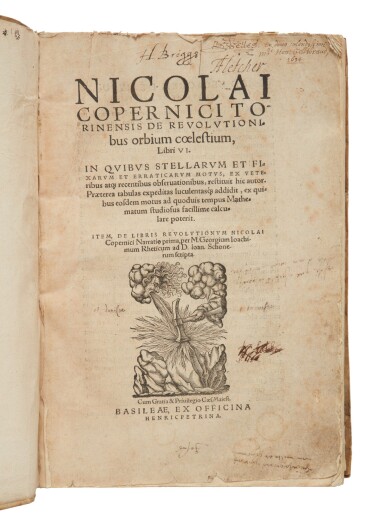
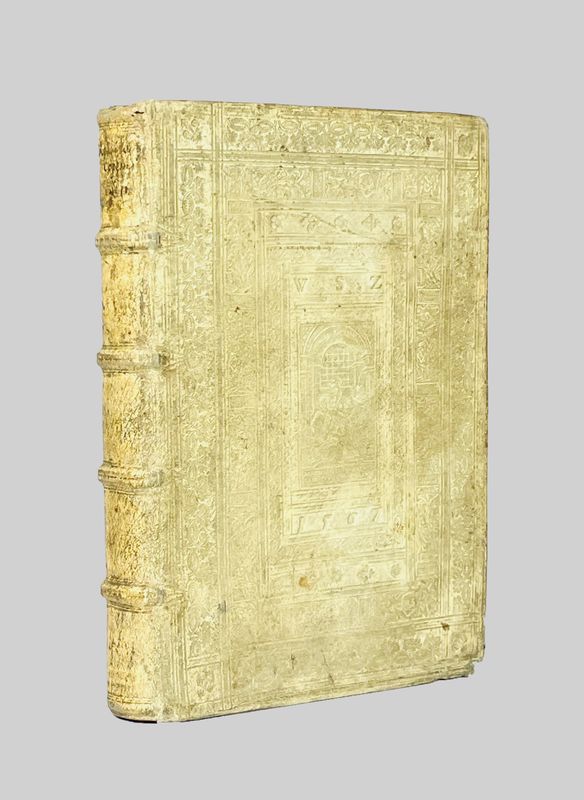
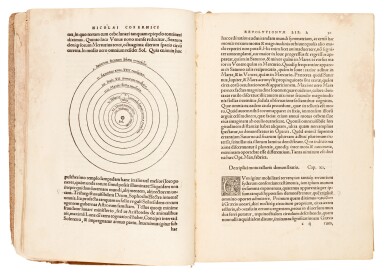


.jpg)

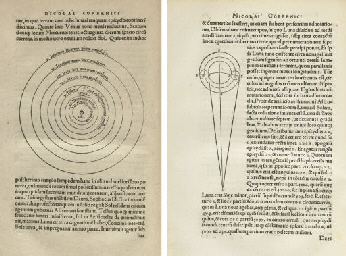
.jpg)
.jpg)
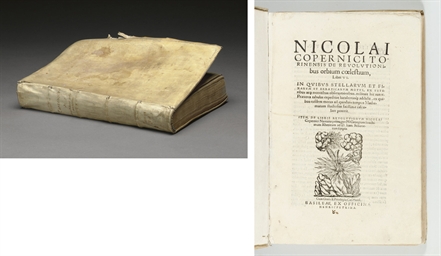
Testen Sie LotSearch und seine Premium-Features 7 Tage - ohne Kosten!
Lassen Sie sich automatisch über neue Objekte in kommenden Auktionen benachrichtigen.
Suchauftrag anlegen